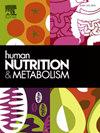一项病例对照研究显示,乳素饮食评分和肾结石在男性中呈负相关,而在女性中则不然
IF 1.8
Q3 ENDOCRINOLOGY & METABOLISM
引用次数: 0
摘要
考虑到乳素饮食评分(LVDS)与草酸钙(CaOx)肾结石(KS)形成的关系,我们选择探索这种潜在的联系。方法本研究共纳入620例患者,其中新诊断的CaOx结石310例,对照组310例。通过一份涵盖前一年的经过验证的147项食物频率问卷来评估饮食消费。利用多变量logistic回归分析LVDs与KS之间的关系。结果对照组LVDs(36.62±4.74 vs 35.55±5.27,P = 0.008)、水果摄入量(214.31±116.04 vs 196.58±100.94,P = 0.043)、蔬菜摄入量(322.98±193.89 vs 275.10±154.41,P <;0.001)、乳制品(407.09±224.24 vs 349.71±222.93,P = 0.001)和橄榄油(13.12±2.82 vs 12.47±2.09,P = 0.001)均高于CaOx KS组。单因素logistic回归结果显示,LVD评分每增加一个单位,发生KS的几率降低4.2% (OR = 0.958, P = 0.009)。在调整年龄和BMI后,男性的估计OR为0.95 (P = 0.013)。LVDs第一分位的参与者发生KS的几率比第三分位的参与者高52% (OR = 1.52, P = 0.04)。然而,在调整年龄和BMI后,LVDs的第一和第三十分位男性受试者发生KS的几率有显著差异(调整OR = 1.87, P = 0.02)。类似的差异在女性参与者中不显著(OR = 0.49, P = 0.15)。结论:LVD评分的增加与总体上发生KS的可能性降低有关,其中男性的降低更为明显。本文章由计算机程序翻译,如有差异,请以英文原文为准。
The lacto-vegetarian dietary score and kidney stones are likely to be inversely associated in men but not in women: A case-control study
Objective
Given that the lacto-vegetarian dietary score (LVDS), has not been previously examined in relation to formation of calcium oxalate (CaOx) kidney stones (KS), we chose to explore this potential association.
Methods
This case-control investigation involved 620 individuals, comprising 310 newly diagnosed patients with CaOx stones and 310 control subjects. Dietary consumption was evaluated through a validated 147-item food frequency questionnaire covering the previous year. The relationship between LVDs and KS was analyzed utilizing multivariable logistic regression.
Results
The results of the current study demonstrated that controls had higher mean LVDs (36.62 ± 4.74 vs 35.55 ± 5.27, P = 0.008), intake of fruits (214.31 ± 116.04 vs 196.58 ± 100.94, P = 0.043), vegetables (322.98 ± 193.89 vs 275.10 ± 154.41, P < 0.001), dairy (407.09 ± 224.24 vs 349.71 ± 222.93, P = 0.001) and olive oil (13.12 ± 2.82 vs 12.47 ± 2.09, P = 0.001) than those with CaOx KS. The univariate logistic regression results revealed that each unit increase in LVD score decreases the odds of having KS by 4.2 % (OR = 0.958, P = 0.009). After adjusting for age and BMI, the estimated OR was 0.95 for men (P = 0.013). Participants in the first tertile of LVDs had about 52 % higher odds of having KS than those in the third tertile (OR = 1.52, P = 0.04). However, a significant difference was found in male participants in the first and third tertiles of LVDs regarding the odds of having KS after adjusting for age and BMI (adjusted OR = 1.87, P = 0.02). The similar difference was not significant in female participants (OR = 0.49, P = 0.15).
Conclusion
Increasing in the LVD score is associated with a decrease in the likelihood of developing KS overall, with a more pronounced reduction in men.
求助全文
通过发布文献求助,成功后即可免费获取论文全文。
去求助
来源期刊

Human Nutrition and Metabolism
Agricultural and Biological Sciences-Food Science
CiteScore
1.50
自引率
0.00%
发文量
30
审稿时长
188 days
 求助内容:
求助内容: 应助结果提醒方式:
应助结果提醒方式:


